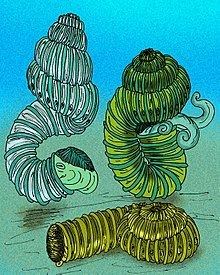Rank Genus Subclass Ammonites | ||
 | ||
Similar Ammonites, Bostrychoceras, Menuites, Pachydiscus, Didymoceras | ||
Nostoceras is an extinct genus of ammonite from the Campanian stage of the Upper Cretaceous, found in the USA, England, central Europe, west Africa, and Madagascar. The etymology of the name Nostoceras comes from "nostos" meaning return and "ceros" meaning horn, named as such by Alpheus Hyatt because it bends back on itself.
Nostoceras is typified by a tightly coiled helical spire on a large U shaped body chamber with the aperture, in mature individuals, nearly touching and lying underneath the spire. The initial helical whorls are covered with fine ribs and may have small spines. The U shaped body chamber has coarser ribbing and large tubercles. Periodic constrictions may be present on the phragmocone. Species may coil either to the left or to the right. Nostoceras is like Bostrychoceras in general form, except that its ribs may be flaired and the constrictions may or may not be present.
Nostoceras is the type genus for the ammonite family Nostoceratidae which is included in the Turrilitoidea. The Turrilitoidea, with Nostoceras and the Nostoceratidae, are commonly included in the suborder Ancyloceratina but may instead belong in the Turrilitina, a proposed order of heteromorphs thought to have a separate derivation, though this separation does not have wide support.
Distribution
Angola, Australia, Austria, Belgium, Denmark, France, Germany, Iraq, Italy, the Netherlands, Nigeria, Oman, Spain, United States
